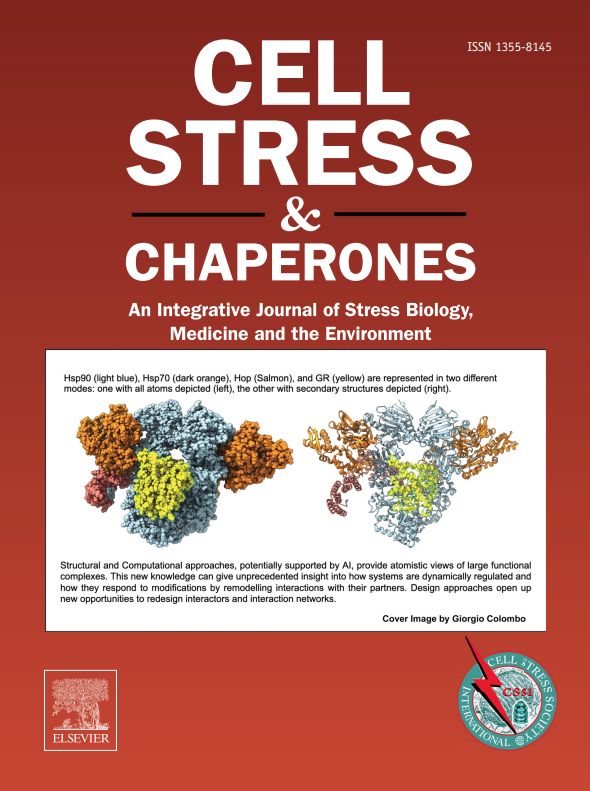Hsp70 and Hsp90 post-translational modifications and translating the chaperone code
IF 3.2
3区 生物学
Q3 CELL BIOLOGY
引用次数: 0
Abstract
Molecular chaperones maintain proteostasis by assisting protein folding, stability, and activity. Heat shock protein 70 (Hsp70) and Hsp90 (Hsp90) are ATP-dependent chaperones essential for protein quality control, signaling, and stress adaptation. Their activities are controlled not only by co-chaperones, but also by dynamic post-translational modifications (PTMs). This review dissects phosphorylation, acetylation, methylation, ubiquitination, glycosylation, and other PTMs of Hsp70 and Hsp90 across systems. These PTMs regulate the ATPase activity, localization, and interactions of the molecular chaperones with major implications in health and disease. The term “chaperone code” describes the PTM landscape that fine-tunes chaperone function. This code governs client fate, drug sensitivity, and stress responses. Importantly, combinatorial PTMs introduce regulatory complexity and flexibility, especially in cancer, neurodegeneration, and inflammation. The crosstalk between various PTMs and feedback loops add new regulatory layers to chaperone function. Additionally, these PTMs impact the function of the clients that are central in regulating specific cellular processes or pathways, such as transcription, autophagy, metabolism, and immune regulation. These pathways are usually affected in different maladies, such cancer, neurodegenerative, infectious and chronic diseases. Unlocking the chaperone code is essential for directing chaperone activity toward therapeutic benefit. This can be achieved by targeting enzymes that write, erase, or read the chaperone code, thereby offering new therapeutic strategies.
Hsp70和Hsp90的翻译后修饰和翻译伴侣代码。
分子伴侣通过协助蛋白质折叠、稳定性和活性来维持蛋白质稳态。热休克蛋白70 (Hsp70)和Hsp90是atp依赖的伴侣蛋白,对蛋白质质量控制、信号传导和应激适应至关重要。它们的活性不仅受到共同伴侣的控制,还受到动态翻译后修饰(PTMs)的控制。本文分析了Hsp70和Hsp90的磷酸化、乙酰化、甲基化、泛素化、糖基化和其他PTMs。这些ptm调节atp酶活性、定位和分子伴侣的相互作用,对健康和疾病有重要影响。术语“伴侣代码”描述了微调伴侣功能的ptm景观。这段代码控制着病人的命运、药物敏感性和应激反应。重要的是,组合PTMs引入了调节的复杂性和灵活性,特别是在癌症、神经变性和炎症中。各种ptm和反馈回路之间的串扰为伴侣功能增加了新的调节层。此外,这些ptm会影响在调节特定细胞过程或途径(如转录、自噬、代谢和免疫调节)中的核心功能。这些途径通常在癌症、神经退行性疾病、传染病和慢性病等不同疾病中受到影响。解开伴侣的密码对于指导伴侣的活动以获得治疗益处至关重要。这可以通过靶向写、擦除或读取伴侣编码的酶来实现,从而提供新的治疗策略。
本文章由计算机程序翻译,如有差异,请以英文原文为准。
求助全文
约1分钟内获得全文
求助全文
来源期刊

Cell Stress & Chaperones
生物-细胞生物学
CiteScore
7.60
自引率
2.60%
发文量
59
审稿时长
6-12 weeks
期刊介绍:
Cell Stress and Chaperones is an integrative journal that bridges the gap between laboratory model systems and natural populations. The journal captures the eclectic spirit of the cellular stress response field in a single, concentrated source of current information. Major emphasis is placed on the effects of climate change on individual species in the natural environment and their capacity to adapt. This emphasis expands our focus on stress biology and medicine by linking climate change effects to research on cellular stress responses of animals, micro-organisms and plants.
 求助内容:
求助内容: 应助结果提醒方式:
应助结果提醒方式:


